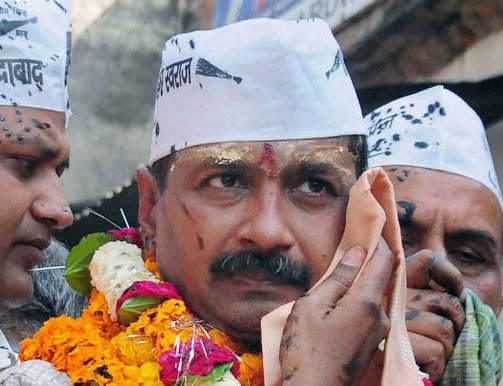
In the chilling winter of Delhi exactly six months ago, the political scene in the Indian capital had warmed up after the newbie Aam Aadmi Party (AAP) registered a historic win in the assembly elections in the Indian capital. Riding on the wave of the anti-corruption movement targeted against the ruling Congress, the AAP hogged all headlines by securing a surprise win a year after it was formed. It was the talk of the town. The win brought its leader and the civil servant-turned politician Arvind Kejriwal at the helm of affairs as the state’s Chief Minister.
Six months down the road the party is now in tatters despite such a spectacular debut. After a dismal show in the Lok Sabha elections, AAP, which had decided to go national much to the surprise of many, finds itself in a huge muddle. It’s growth story has suddenly been cut short. Voters are thoroughly disenchanted with the party. The party’s plans and policies seem to have gone haywire. Dissent within the party is growing. Many have started to leave it. It's heroic leader who guided the party to a spectacular victory in the Delhi polls is directionless after the national elections.
So what caused the party's debacle ? The main reason is the lack of inner party democracy. AAP has functioned as an one man’s show until now. Party president Kejriwal has taken decisions in the party almost unilaterally without any consultations with his party members. The party, a strong critique of crony capitalism, is itself being run by a crony clique. Members have alleged that apart from unilateral decisions by Kejriwal, decision making is concentrated in the hands of a few senior leaders. Kejriwal’s abrupt decision to quit as the CM of Delhi is an example. His decision to stand from Varanasi against Narendra Modi was also not based on discussion with party members. Kejriwal seemed to show an authoritarian antic that upset many of his trusted colleagues. Founding member and one of the party’s most prominent faces Shazia Ilmi quit the party alleging that while the party championed the principle of Swaraj, there was no Swaraj in the party itself. Simmering discontent among the volunteers and their voices not being heard was seen during the ticket distribution process when they unsuccessfully protested the some of the party's candidacies. The weakening support base has also contributed to the party’s drubbing. The middle class, which formed its strong support base, is thoroughly disenchanted. It all started with Kejriwal’s decision to quit as the CM within 50 days in office. The move got him an escapist label and many doubted his competency. By the time Kejriwal decided to go for another one of his sit-ins against the Home Ministry just before his resignation, the middle class was already tired with his agitational politics. This, coupled with his impulsive decisions largely contributed to the displeasure against the party. AAP was only able to raise one fifth of its targeted goal of a billion rupees for the general elections. It showed the lack of support from his previous donors. His decision to go to jail soon after the elections on the Gadkari defamation case gained even more flak. It was seen as a sensation-seeking drama. The party's tactics of agitation and sit-ins has led to the loss of many supporters.
AAP’s dismal show in the elections can also be attributed to its quixotic policies. The party fielded 434 candidates -- out of the total 545 seats at stake - more than the Congress and the BJP. It stretched beyond its means and suffered the consequences. It was able to secure merely four seats -- from Punjab -- but drew a blank in its stronghold, Delhi. Kejriwal’s decision to take on Modi in Vanarasi instead of contesting from the Delhi constituency went on to prove that he was essentially a political maverick not an astute politician. AAP's highly idealistic manifesto turned out to be a damp squib in the national elections. A big departure from what was seen during the Delhi assembly elections.
Now, with party stalwarts Yogendra Yadav and Navin Jaihind quitting from the top decision making bodies due to conflict of interests, the party is in deep waters. The bruised and battered party has two major daunting task ahead: revitalize the demoralized members and gain trust of the crestfallen voters. It will be very difficult for the party to regain the lost grounds. But the AAP has no other choice but to do a thorough self-introspection and mend its ways to avoid what now looks a certain embarrassment when the assembly elections are held in a few months' time.
- Ukrainian Crisis And The World (Dis)Order
- Apr 22, 2022
- China’s Cautious Steps In The Graveyard Of Empires
- Aug 18, 2021
- Foreign Aid On The Fence!
- Aug 08, 2021
- Communist Party of China centenary celebrations Reading between the lips
- Jul 14, 2021
- Second Wave Of Covid-19 In India: Deadly Blow To The Economy
- Jun 23, 2021
















